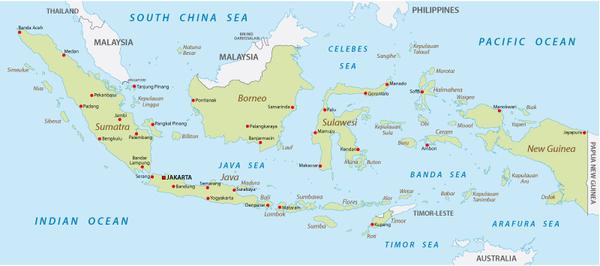
Geography of Indonesia
Official name: Republic of Indonesia
Capital: Jakarta
Population: 265,061,322 people (in 2017)
Surface area: 1,913,579 km²
Official language: Bahasa Indonesia (Indonesian language)
Currency: Indonesian Rupiah (IDR)
Indonesia is the world’s largest archipelago. It comprises 16,056 islands (official statistics of 2017) of which only 6,000 are inhabited. Because not all the islands have been identified and listed yet, the total amount is estimated to 18,000 islands. By surface area, Indonesia occupies the world’s fifteenth rank. It is the fourth most populated country behind China, India and the United States.
The borders of Indonesia
The Indonesian archipelago shares land borders with Malaysia, Papua New Guinea and East Timor. It is surrounded by the Indian Ocean on the west and the Pacific Ocean on the east. Its interior comprises many seas like the Java Sea, the Banda Sea, the Celebes Sea and the Molucca Sea, to name just a few.The reliefs on the Indonesian archipelago
The terrain of the archipelago presents a variety of patterns with about 150 volcanoes that belong to the Pacific Ring of Fire. But the highest peak is not a volcano. On the Indonesian side of New-Guinea island, a major mountain range exceeding 3,600 meters above sea level stretches from east to west. Mount Puncak Jaya, also called Carstensz Pyramid, culminates the area at 4 884 metres. Apart from rugged relief, plains fill an important portion of the country, especially in Java, Sumatra and Borneo.Indonesia, a volcanically active country
Indonesia’s volcanic activity is one of the highest in the world. Of 150 volcanoes, 70 are active. Mount Merapi in the region of Yogyakarta is one of the most closely monitored volcanoes due to its close proximity to a large urban population.The main islands of the archipelago
Numerous islands and island clusters compose the Indonesian archipelago, each with its own distinct natural environment. We made a list of the main islands to explore when travelling in Indonesia.
See as well
NOS CIRCUITS
Lie a ce conseil de voyage
Parfum the Mongolie
14 jours - 2,350$
Parfum the Mongolie
14 jours - 2,350$

